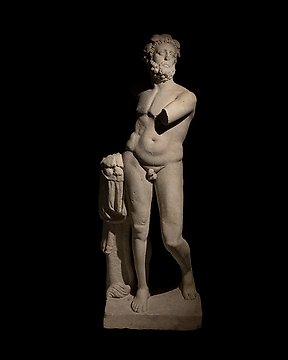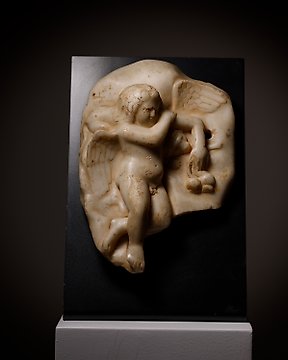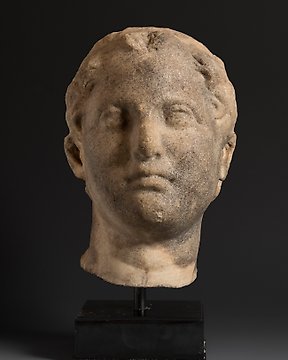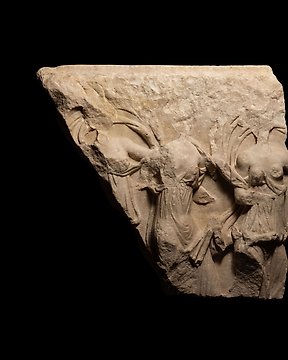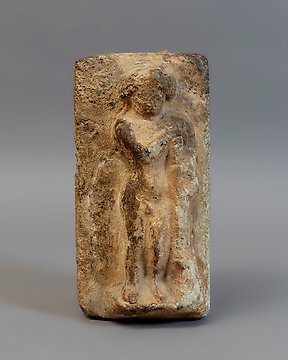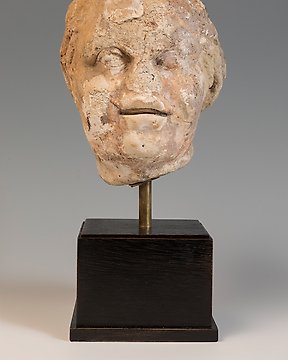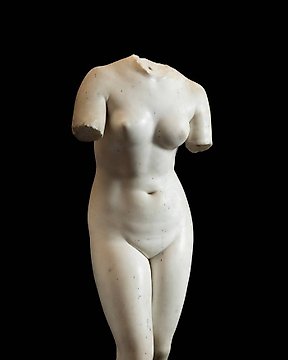All OK and with very fast shipping.
Προβολή μετάφρασηςΑρχαία Ρωμαϊκή Μάρμαρο Ωραίο κεφάλι ενός Σατύρου. 1ος-2ος αιώνας μ.Χ. 13 εκ. Υ. Εξ. Royal-Athena Galleries. Ισπανική
Αρ. 84871977


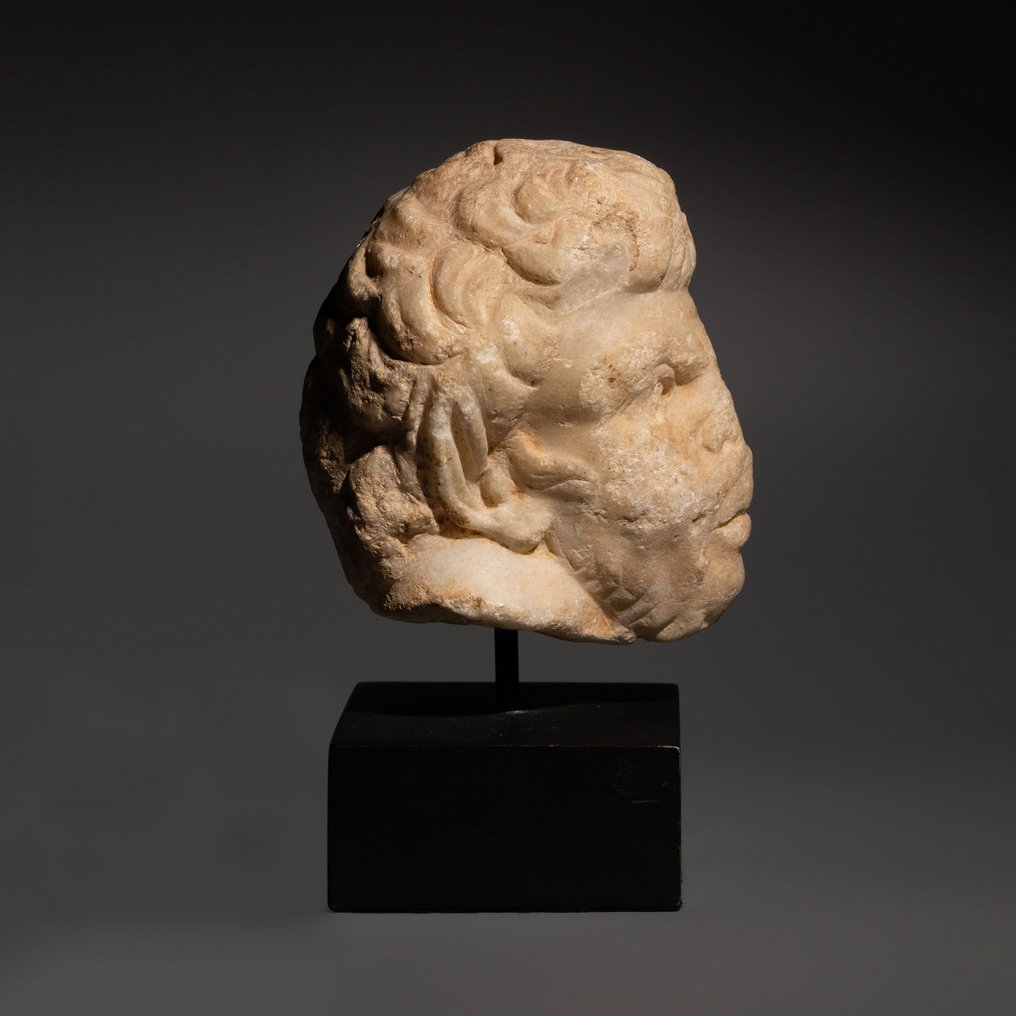
Nice head of a Satyr
Roman Empire, 1st - 2nd century AD
MATERIAL: Marble
DIMENSIONS: 20 cm height with stand, 13 cm height without stand.
PROVENANCE:
- Private collection, J. Haering, Germany.
- Royal-Athena Galleries, New York, 2013.
- Private collection, New York.
PUBLICATIONS:
- Art of the Ancient World. Volume XXIV. Royal-Athena Galleries. New York. 2013. Fig. 10. (See last photos).
CONDITION: Good, without restorations, it presents abrasions on the surface of the marble, especially in the area of the cheeks.
DESCRIPTION:
This Roman satyr head is made of marble. We recognize the mythological creature by its pointed ears, thick lips and hybrid features, between human and goat. Possibly, it had small horns.
Satyrs were related to the Maenads, and together made up the retinue of Dionysus. They can also be associated with the god Pan. Some traditions consider Silenus to be the father of the tribe of satyrs. The three principal ones were Maron, Leneus and Astraios, and as they were like their father, they are also known as Sileni. According to some versions of the myth, these three were the fathers of the other satyrs (of whom Silenus was in this instance the grandfather). The three were in the entourage of Dionysus when he travelled to India, and it was Astaios who drove his carriage.
A satyr is the equivalent of a faun in Roman mythology. A faun was a god of the fields and woods, a protector of the flocks. These he made more productive and protected from attacks by beasts of prey. Another facet of a faun was his role as an oracular god who revealed the future through voices that could be heard in the woods and in dreams: sometimes he was considered to be responsible for nightmares. He is represented as a lascivious creature, always chasing nymphs in the woods. It was also believed that he could hex peasants, and for this reason they would rub their bodies with certain herbs as a form of protection.
Although it is Roman, this piece in question follows Greek lines as does much sculpture, and therefore the iconography is that of a Greek satyr sleeping after sylvan revelry, a bacchanalia of dancing under the light of the moon. One of the most iconic images, and one of the masterpieces of classical antiquity is the Barberini Faun, one of the most important works from the school of Rhodes. The figure is sleeping, almost agonising, lying on an animal skin with both legs wide apart in an explicitly sexual posture.
Some experts maintain that the Barberini Faun is an ancient copy of a bronze original. However, the marble sculptures were always considered to be more valuable and better finished as they achieved surface textures unobtainable with cast metal, and for this reason they were painted in polychrome and kept under shelter. They appeared so real and fabulous that even after they had lost their colouring they were extremely beautiful, and so in the end the custom of leaving them unpainted prevailed.
One of the preferred motifs was the expedition of Dionysus to India accompanied by his retinue. This god was not only that of winemaking but also by extension a god of theatre and agriculture. His fundamental role, however, was that of liberating man from his preoccupations through ecstasies and ritual madness (produced by music, wine and sex). In the entourage of Dionysus we find the satyrs and bacchantes. The satyrs, confounded with the fauns, were represented as old and ugly (and could be violent and evil) until Praxiteles made them less violent and more youthful in his “Resting Satyr”. After this they began to be depicted as more beautiful figures, such as this one in question.
Notes:
- The piece includes authenticity certificate.
- The piece includes Spanish Export License (Passport for European Union) - If the piece is destined outside the European Union a substitution of the export permit should be requested, can take between 1-2 weeks maximum.
- The seller guarantees that he acquired this piece according to all national and international laws related to the ownership of cultural property. Provenance statement seen by Catawiki.
THE MINISTRY OF CULTURE FROM SPAIN ASKS ALL SELLERS FOR INVOICES OR OTHER DOCUMENTATION ABLE TO PROVE THE LEGALITY OF EACH ITEM BEFORE PROVIDING AN IMPORT OR EXPORT LICENSE.
#ancientcivilisations
Ιστορία πωλητή
Nice head of a Satyr
Roman Empire, 1st - 2nd century AD
MATERIAL: Marble
DIMENSIONS: 20 cm height with stand, 13 cm height without stand.
PROVENANCE:
- Private collection, J. Haering, Germany.
- Royal-Athena Galleries, New York, 2013.
- Private collection, New York.
PUBLICATIONS:
- Art of the Ancient World. Volume XXIV. Royal-Athena Galleries. New York. 2013. Fig. 10. (See last photos).
CONDITION: Good, without restorations, it presents abrasions on the surface of the marble, especially in the area of the cheeks.
DESCRIPTION:
This Roman satyr head is made of marble. We recognize the mythological creature by its pointed ears, thick lips and hybrid features, between human and goat. Possibly, it had small horns.
Satyrs were related to the Maenads, and together made up the retinue of Dionysus. They can also be associated with the god Pan. Some traditions consider Silenus to be the father of the tribe of satyrs. The three principal ones were Maron, Leneus and Astraios, and as they were like their father, they are also known as Sileni. According to some versions of the myth, these three were the fathers of the other satyrs (of whom Silenus was in this instance the grandfather). The three were in the entourage of Dionysus when he travelled to India, and it was Astaios who drove his carriage.
A satyr is the equivalent of a faun in Roman mythology. A faun was a god of the fields and woods, a protector of the flocks. These he made more productive and protected from attacks by beasts of prey. Another facet of a faun was his role as an oracular god who revealed the future through voices that could be heard in the woods and in dreams: sometimes he was considered to be responsible for nightmares. He is represented as a lascivious creature, always chasing nymphs in the woods. It was also believed that he could hex peasants, and for this reason they would rub their bodies with certain herbs as a form of protection.
Although it is Roman, this piece in question follows Greek lines as does much sculpture, and therefore the iconography is that of a Greek satyr sleeping after sylvan revelry, a bacchanalia of dancing under the light of the moon. One of the most iconic images, and one of the masterpieces of classical antiquity is the Barberini Faun, one of the most important works from the school of Rhodes. The figure is sleeping, almost agonising, lying on an animal skin with both legs wide apart in an explicitly sexual posture.
Some experts maintain that the Barberini Faun is an ancient copy of a bronze original. However, the marble sculptures were always considered to be more valuable and better finished as they achieved surface textures unobtainable with cast metal, and for this reason they were painted in polychrome and kept under shelter. They appeared so real and fabulous that even after they had lost their colouring they were extremely beautiful, and so in the end the custom of leaving them unpainted prevailed.
One of the preferred motifs was the expedition of Dionysus to India accompanied by his retinue. This god was not only that of winemaking but also by extension a god of theatre and agriculture. His fundamental role, however, was that of liberating man from his preoccupations through ecstasies and ritual madness (produced by music, wine and sex). In the entourage of Dionysus we find the satyrs and bacchantes. The satyrs, confounded with the fauns, were represented as old and ugly (and could be violent and evil) until Praxiteles made them less violent and more youthful in his “Resting Satyr”. After this they began to be depicted as more beautiful figures, such as this one in question.
Notes:
- The piece includes authenticity certificate.
- The piece includes Spanish Export License (Passport for European Union) - If the piece is destined outside the European Union a substitution of the export permit should be requested, can take between 1-2 weeks maximum.
- The seller guarantees that he acquired this piece according to all national and international laws related to the ownership of cultural property. Provenance statement seen by Catawiki.
THE MINISTRY OF CULTURE FROM SPAIN ASKS ALL SELLERS FOR INVOICES OR OTHER DOCUMENTATION ABLE TO PROVE THE LEGALITY OF EACH ITEM BEFORE PROVIDING AN IMPORT OR EXPORT LICENSE.
#ancientcivilisations
Ιστορία πωλητή
- 744
- 6
- 0
Prachtig schilderij. Zo blij mee. Zeer nette verkoper en zeer snelle levering.
Προβολή μετάφρασηςperfect ! very fast and high quality delivery !
Προβολή μετάφρασηςAll well! Thanks.
Προβολή μετάφρασηςVendeur très professionnel, top +++×
Προβολή μετάφρασηςPhotos trop contrastées pour bien percevoir les défauts, mais ces défauts étaient visibles pour autant. Le "Bon état" est trompeur. Sinon, envoi rapide et correctement emballé. Frais de port exagérés.
Προβολή μετάφρασηςGreat communication, delivery and product. Came with a well made certificate of authenticity and good packaging. Overall very happy with the purchase! Delivery is a bit expensive, but I recommend it
Προβολή μετάφρασηςMagnifique témoin du passé, envoyé avec tous les justificatifs, impeccable. Encore une fois très satisfait, un grand merci
Προβολή μετάφρασηςThank you for the Special offer and the fast shipping of this excellent piece of art!
Προβολή μετάφρασηςvery good description of the object, very good price for this rare item,. Fast sending (has been at my place 2 days after buying!). Definitely would buy again.
Προβολή μετάφρασηςSehr schön
Προβολή μετάφρασηςAs described, perfect logistic
Προβολή μετάφρασηςgreat seller, everything came as should with certificate of authenticity
Προβολή μετάφρασηςExceptionally well packaged, description aligned with positing received
Προβολή μετάφρασηςReally precious, but without sound...
Προβολή μετάφρασηςPainting well packed and rapidly sent!
Προβολή μετάφρασηςsempre grande rapidità e professionalità
Προβολή μετάφρασηςparfait bien reçu, merci
Προβολή μετάφρασηςVery satisfied with the small Greek Lekythos. As always (we have already bought several items from Bagot), the object was wrapped and sent immediately and with the greatest care.
Προβολή μετάφρασηςPerfect, excellent condition, good packaging, the parcel arrived without any problems… all is perfect as usual. Thank you very much and wait for an other nice piece like this one. Gilles.
Προβολή μετάφρασης+++ Top vendeur professionnel comme d'habitude
Προβολή μετάφρασηςEmbora o custo de transporte esteja acima da média foi, realmente, muito bem executado e em embalagem cuidada. Expeditos e profissionais. Recomendo
Προβολή μετάφρασηςSnel en correct en goed verpakt verzonden
Προβολή μετάφρασηςoggetto bellissimo, fedele alla descrizione, venditore affidabile
Προβολή μετάφρασηςVery nice piece and fast delivery
Προβολή μετάφρασης- 744
- 6
- 0
All OK and with very fast shipping.
Προβολή μετάφρασηςΑποποίηση ευθυνών
Ο πωλητής εγγυάται και μπορεί να αποδείξει ότι το αντικείμενο αποκτήθηκε νόμιμα. Ο πωλητής ενημερώθηκε από την Catawiki ότι έπρεπε να παράσχει τα δικαιολογητικά που απαιτούνται από τους νόμους και τους κανονισμούς στη χώρα διαμονής τους. Ο πωλητής εγγυάται και δικαιούται να πουλήσει/εξάγει αυτό το αντικείμενο. Ο πωλητής θα παρέχει στον αγοραστή όλες τις πληροφορίες προέλευσης που είναι γνωστές για το αντικείμενο. Ο πωλητής διασφαλίζει ότι οποιεσδήποτε απαραίτητες άδειες έχουν ήδη κανονιστεί /θα κανονιστεί. Ο πωλητής θα ενημερώσει αμέσως τον αγοραστή για τυχόν καθυστερήσεις στην απόκτηση τέτοιων αδειών.
Ο πωλητής εγγυάται και μπορεί να αποδείξει ότι το αντικείμενο αποκτήθηκε νόμιμα. Ο πωλητής ενημερώθηκε από την Catawiki ότι έπρεπε να παράσχει τα δικαιολογητικά που απαιτούνται από τους νόμους και τους κανονισμούς στη χώρα διαμονής τους. Ο πωλητής εγγυάται και δικαιούται να πουλήσει/εξάγει αυτό το αντικείμενο. Ο πωλητής θα παρέχει στον αγοραστή όλες τις πληροφορίες προέλευσης που είναι γνωστές για το αντικείμενο. Ο πωλητής διασφαλίζει ότι οποιεσδήποτε απαραίτητες άδειες έχουν ήδη κανονιστεί /θα κανονιστεί. Ο πωλητής θα ενημερώσει αμέσως τον αγοραστή για τυχόν καθυστερήσεις στην απόκτηση τέτοιων αδειών.

